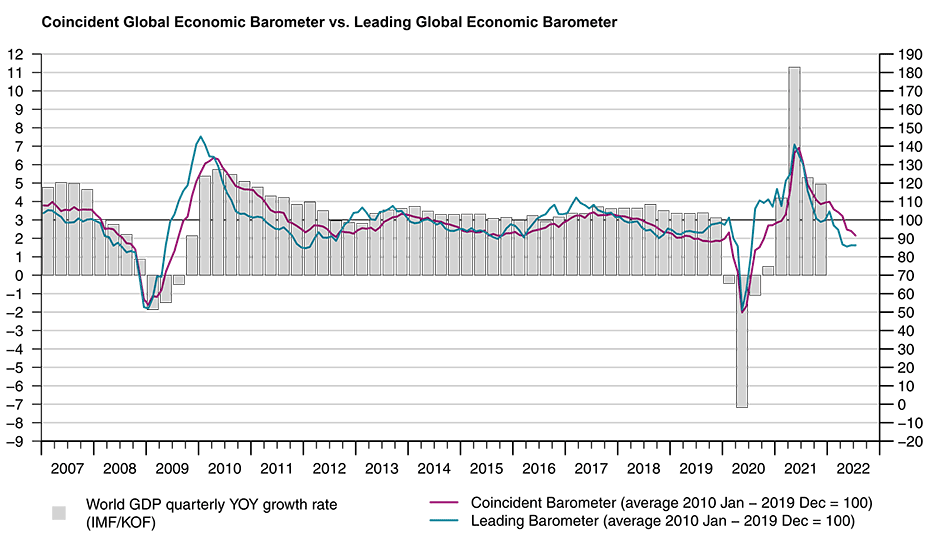Confirmed slowdown tendency of Global Barometers
The Global Barometers overall continue to signal a strong deceleration in world economic growth in 2022. In July, the Coincident Barometer declines for the sixth consecutive month, while the Leading Barometer continues to be 10 points below the historical mean of 100 points. The results reflect a gloomy outlook for global economic growth in the coming months.
The Coincident Global Economic Barometer declines 2.5 points in July, to 91.5 points, accumulating losses of almost 20 points since last February, while the Leading Global Economic Barometer remains stable this month at 86.2 points. The decrease in the coincident indicator is influenced by renewed worsening of conditions in the Western Hemisphere, followed by Europe.
“The coincidence indicator continues to decline and is approaching the low but relatively stable level of the leading indicator. Hence, the actual economic situation continues to worsen – the outlook remains subdued. Whereas Asia is slowly moving out of its downturn, the opposite holds for Europe and the Americas. Especially in Europe, the war in Ukraine is causing an energy crisis and uncertainties on many fronts that are not favourable for short-term economic development”, evaluates Prof Jan-Egbert Sturm, Director of KOF Swiss Economic Institute.
“The Barometers signal that the actual economic situation continues to worsen – the outlook remains subdued. Whereas Asia is slowly moving out of its downturn, the opposite holds for Europe and the Americas.”Jan-Egbert Sturm
Coincident Barometer – regions and sectors
In July, the Western Hemisphere and Europe contribute negatively 1.5 and 1.1 points, respectively, to the decrease in the Coincident Global Barometer, while the Asia, Pacific, and Africa region remained relative stable with small positive contribution of 0.1 points. The drop in the global indicator is at least partly caused by the additional supply restrictions related to the Russian-Ukrainian War. The gradual recovery of the Chinese economy, after easing the mobility restrictions adopted to combat an outbreak of Covid-19, may have positively influenced the Asia, Pacific, and Africa region slightly for the second consecutive month. Nevertheless, the region remains responsible for more than half of the 39.2-point fall in the global indicator during the previous 12 months. The graph below illustrates the contribution of each region to the deviation of the Coincident Barometer from the historical mean of 100 points.
Among the coincident sector indicators, only the Services sector increases this month. All the remaining sectors decrease, especially Trade, with a fall of 8.5 points. With this result, all the indicators move further below the historical mean of 100 points. The Construction sector records its lowest level since July 2020 (64.7 pts.)
Leading Barometer – regions and sectors
The Leading Global Barometer leads the world economic growth rate cycle by three to six months on average. In July, the global indicator remains stable at 86.2 points. As with the Coincident Barometer, the Western Hemisphere and Europe contribute negatively to the Leading Barometer result. In contrast, the Asia, Pacific, and Africa region moves in the opposite direction, partially compensating the more noticeably decreases of previous months by contributing 1.7 points to the development of the Leading Barometer. Global growth expectations for 2022 have been worsening as a result of continuing conflict between Ukraine and Russia and the adoption of more restrictive monetary policies in various countries. These factors have contributed to keeping the global indicator below the long-term average.
Three of the five leading indicator sectors decrease in July. Only the indicators for the general state of the Economy (aggregated business and consumer evaluations) and Industry increase this month. All indicators remain far below the historical mean of 100 points.
The Global Economic Barometers
The Global Economic Barometers are a system of indicators enabling timely analysis of global economic development. They represent a collaboration between the KOF Swiss Economic Institute of the ETH Zurich in Switzerland and Fundação Getulio Vargas (FGV), based in Rio de Janeiro, Brazil. The system consists of two composite indicators, the Coincident Barometer and the Leading Barometer. The Coincident Barometer reflects the current state of economic activity, while the Leading Barometer provides a cyclical signal roughly six months ahead of current economic developments.
The two Barometers comprise the results of economic tendency surveys conducted in more than 50 countries with the aim of achieving the broadest possible global coverage. The advantages of economic tendency surveys are that their results are usually readily available and are not substantially revised after first publication.
The Coincident Barometer includes more than 1,000 different time series, while the Leading Barometer consists of over 600 time series. Cross-correlation analysis is used to decide which individual time series are included in the barometers. This involves correlating the individual time series with a reference series. The reference series used is the year-on-year growth rate of global gross domestic product (GDP), where the individual national GDPs are aggregated at purchasing power parity to form global GDP. A time series is only included in a Barometer if it shows a sufficiently high correlation and a suitable synchronization or lead with the reference series. The time period used for this correlation analysis currently runs from January 2010 to December 2019.
The series of the two Barometers are revised each month at publication and are standardized to have a mean of 100 and a standard deviation of 10 for the 10-year period previous to the most recent observations.
The methodology is described in:
Klaus Abberger, Michael Graff, Aloisio Jr. Campelo, Anna Carolina Lemos Gouveia, Oliver Müller and Jan-Egbert Sturm (2020), The Global Economic Barometers: Composite indicators for the world economy. KOF Working Papers, vol. 471, Zurich: KOF Swiss Economic Institute, ETH Zurich, 2020.
Contact
KOF Konjunkturforschungsstelle
Leonhardstrasse 21
8092
Zürich
Switzerland

